Students get through AP Inter 1st Year Physics Important Questions 4th Lesson Motion in a Plane which are most likely to be asked in the exam.
AP Inter 1st Year Physics Important Questions 4th Lesson Motion in a Plane
Very Short Answer Questions
Question 1.
The vertical component of a vector is equal to its horizontal component. What is the angle made by the vector with X-axis? [TS 18; AP 19; lmp.Q]
Answer:
Vns Let ‘θ’ be angle made by the vector \(\overrightarrow{R}\) with the X-axis.
Vertical component of \(\overrightarrow{R}\) = R sinθ
Horizontal component of \(\overrightarrow{R}\) = R cosθ
∴ Rcosθ = Rsinθ ⇒ tanθ = 1 ⇒ θ = 45°
Question 2.
A vector \(\overline{\mathrm{v}}\) makes an angle e with the horizontal.
The vector is rotated through an angle e. Does this rotation change the vector ‘v\
Answer:
By rotating the vector \(\overline{\mathrm{v}}\) through angle V it’s magnitude does not change, but its horizontal and vertical components change. Also direction of the vector changes. So the rotation changes the vector \(\overline{\mathrm{v}}\).
Question 3.
Two forces of magnitudes 3 units and 5 units act at 60° with each other. What is the magnitude of their resultant? |AP 15,16,17||TS 22|
Answer:
Here, P = 3 and Q = 5 and θ = 60° ⇒ cosθ = cos60° = 1/2

Question 4.
If \(\overrightarrow{A}\) = \(\overrightarrow{i}+\overrightarrow{j}\) What is the angle between vector \(\overrightarrow{A}\) with x -axis? [IPE’ 13, 13, 14; AP 20, 22; TS 17, 20]
Answer:
Comparing the vector \(\overrightarrow{i}+\overrightarrow{j}\) with \(x\overrightarrow{i}+y\overrightarrow{j}\). we get x = 1 and y = 1
If \(\overline{\mathrm{A}}\) = \(x\overline{\mathrm{i}}+y\overline{\mathrm{j}}\) makes an angle θ with the x-axis then tan θ = \(\frac{y}{x}=\frac{1}{1}\) = 1 (∵ θ = 45°)
Question 5.
When two right-angled vectors of magnitude 7 units and 24 units combine, what is the magnitude of their resultant? [IPE’ 14; AP 16,18]
Answer:
Herc, P = 7 and Q = 24 and θ = 90° ⇒ cosθ = cos90° = 0

![]()
Question 6.
If \(\overrightarrow{P}=2\overrightarrow{i}+4\overrightarrow{j}+14\overrightarrow{k}\) and \(\overrightarrow{Q}=4\overrightarrow{i}+4\overrightarrow{j}+10\overrightarrow{k}\) find the magnitude of P + Q. [TS 15, 16, 19, 22]
Answer:

Question 7.
a vector of magnitude zero have a non zero components?
Answer:
No. A vector of magnitude zero cannot have non-zero components.

Question 8.
What is the acceleration of a projectile at the top of its projectory? [AP, TS 19]
Answer:
At the top of its projectory, the direction of acceleration is vertically downwards and its value is 9.8ms-2.
Question 9.
Can two vectors of unequal magnitude add up to give the zero vector? Can three unequal vectors?
Answer:
No, the addition of two un equal vectors cannot give a zero vector
But three un equal vectors lying in a plane can give a zero vector, if triangle law is satisfied.
Short Answer Questions
Question 1.
State Parallelogram law of vectors. Derive an expression for the magnitude and direction of the resultant vector. [AP 22; TS 16, 17, 20, 22]
Answer:
Parallelogram law :
‘If two vectors are represented in magnitude and direction by the two adjacent sides of a parallelogram drawn from a point then their resultant is represented in magnitude and direction by the diagonal passing through the same point’.
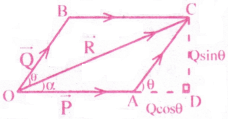
Let two vectors \(\overrightarrow{P}\) = \(\overrightarrow{OA}\) and \(\overrightarrow{Q}\) = \(\overrightarrow{OB}\) be acting simultaneously at a point ‘O’.
Let ‘θ’ be the angle between the two vectors \(\overrightarrow{P} and \overrightarrow{Q}\) and Q.
Now, the parallelogram OACB is completed.
Then, the diagonal \(\overrightarrow{OC}\) represents the resultant vector \(\overrightarrow{R}\).
Now OA is produced and a perpendicular CD is drawn.
Then ∠CAD = θ
Also, |\(\overrightarrow{OA}\)| = OA = P and |\(\overrightarrow{OB}\)| = OB = AC = Q
Magnitude of the Resultant vector \(\overrightarrow{R}\) :
From the right angled triangle COD,
OC² = OD² + CD²
⇒ OC² = (OA+AD)² + CD² (Since, OD = OA + AD)
⇒ OC² = OA² + AD² + 2OA . AD + CD² ⇒ OC² = OA² + (AD² + CD²) + 2OA . AD ——— (1)
Now, from the right angled triangle C AD . AC² = AD² + CD² ——- (2)

Direction of the resultant :
Let the resultant \(\overrightarrow{R}\) makes an angle ‘α’ with \(\overrightarrow{P}\).
![]()
Question 2.
What is relative motion. Explain it?
Answer:
Relative motion :
The motion of a body with respect to another body is called relative motion between them.

Consider two bodies A,B moving with Velocities VA and VB.
(i) If A and B are moving in the same direction then
the relative velocity of A with respect to B is \(\overrightarrow{V}_{AB}=\overrightarrow{V}_{A}-\overrightarrow{V}_{B}\)
The relative velocity of B with respect to A is \(\overrightarrow{V}_{BA}=\overrightarrow{V}_{B}-\overrightarrow{V}_{A}\)
(ii) If A and B are moving in opposite directions then
the relative velocity of A with respect to B is \(\overrightarrow{V}_{AB}=\overrightarrow{V}_{A}-(-\overrightarrow{V}_{B})=\overrightarrow{V}_{A}+\overrightarrow{V}_{B}\).
Question 3.
Show that a boat must move at an angle of 900 with respect to river water in order to cross the river in a minimum time?
Answer:
Consider a boat starts at a point A on one bank of the river and intends to reach the other bank, as shown in the Fig.
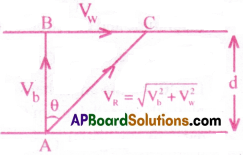
If the velocity of boat in still water is Vb, and velocity of water in the river is Vw then Resultant velocity is

In the above expression, the denominator VR is constant (since Vb, Vw are fixed /given)
Hence ‘t’ becomes minimum when AC becomes minimum. The minimum value of AC is nothing but AB, which is equal to the width ‘d’ of the river. Here AB is perpendicular to Vw.
Thus, the boat must move at an angle of 90° with respect to the river water.
Question 4.
Define unit vector, Null vector and position vector [AP 15]
Answer:
Unit Vector :
A vector of magnitude one unit is called a unit vector.
Null Vector :
A vector of zero magnitude and arbitrary direction is called a zero vector or Null vector.

Position Vector :
The position vector of a point P is the vector from the origin ‘O’ of the coordinate system to the position of the point. It is denoted by \(\overrightarrow{OP}\).
If (x,y,z) are the co-ordinates of a point ‘P’ and ‘O’ is the origin of coordinate system then \(\overrightarrow{OP}=\overrightarrow{r}=x\hat{i}+y\hat{j}+z\hat{k}\) is the position vector of P.
Magnitude of \(\overrightarrow{r}\) is |\(\overrightarrow{r}\)| = \(\sqrt{x^2+y^2+z^2}\)
Question 5.
If |\(\overrightarrow{a}+\overrightarrow{b}\)| = |\(\overrightarrow{a}-\overrightarrow{b}\)| then what is the angle between \(\overrightarrow{a}\) and \(\overrightarrow{b}\)? [AP 19; TS 18, 22]
Answer:

Question 6.
Show that the trajectory of an object thrown at a certain angle with the horizontal is a parabola. [AP 20; IPE’ 13,14; AP, TS 15, 16, 17, 18, 19, 22]
Answer:
1) Suppose an object is projected from the origin ‘O’ with an initial velocity u at an angle 0 with the horizontal.
Horizontal component of u is ux = ucosθ
Vertical component of u is uy = usinθ
2) Motion along horizontal: The horizontal component ux= ucosθ and ax = 0.
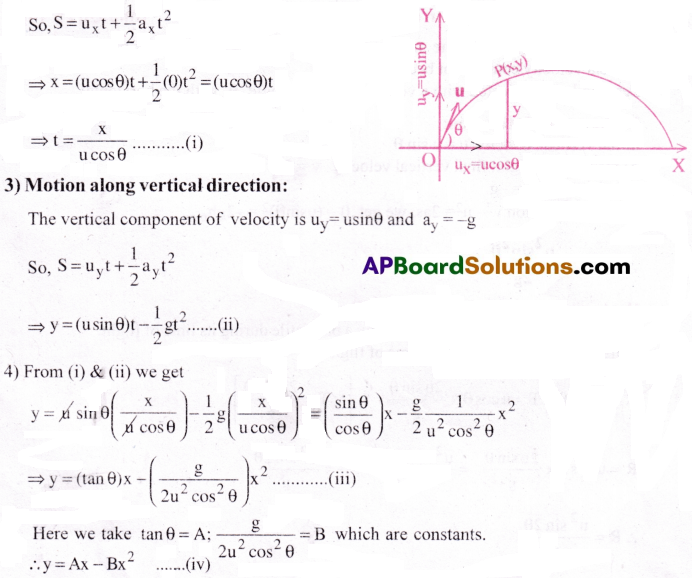
Thus, (iv) represents the equation of a parabola.
So, the trajectory of a projectile is a parabola.
![]()
Question 7.
Explain the terms average velocity and instantaneous velocity. When are they equal?
Answer:
Average velocity :
Suppose a body is at a point x1 at time t1 and at some other point x2 at time t2, then the displacement of the body is x2 – x1. Hence its average velocity is given by

Instantaneous velocity :
The velocity of an object at a particular point of its path or at a particular instant of time is called as instantaneous velocity.
![]()
During uniform motion, the average and instantaneous velocity are always same because the velocity during uniform motion is same at each point of its path or at each instant.
Question 8.
Show that maximum height and range of projectile are \(\frac{u^2 \sin ^2 \theta}{2 g}, \frac{u^2 \sin 2 \theta}{g}\) respectively when the terms have their regular meaning. [Imp.Q|[TS 16]
Answer:
Maximum height :
It is the maximum vertical distance travelled by the projectile where its vertical velocity component becomes zero.
Let a body be projected with a velocity ‘u’ at an angle ‘θ’ with the horizontal.
In the vertical direction:
Initial vertical velocity u = u sin θ
At maximum height, final vertical velocity v = 0
Acceleration a = -g.
From the equation v² – u²= 2as, we get 0 – (usinθ)² = -2ghmax

Horizontal Range (R) of a projectile :
It is the horizontal distance travelled by a projectile during its time of flight.
Range = Horizontal velocity x time of flight
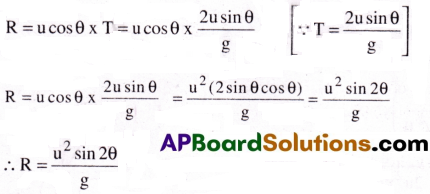
If θ is 45° then the horizontal range of a projectile is maximum.
Question 9.
If the trajectory of a body is parabolic in one reference frame, can it be parabolic in another reference frame that moves at constant velocity with respect to the first reference frame? If the trajectory can be other than parabolic, what else it can be?
Answer:
It will not be parabolic from the second reference frame. It appears to move in a straight line.
Exampler :
Suppose a bomb is dropped from an aeroplane flying at a height with a constant speed. For a stationary observer on the earth, the path of the bomb will be parabola. But for the pilot in the plane, the path of the bomb will look like a vertical straight line.
Question 10.
A force \(2\hat{i}+\hat{j}-\hat{k}\) newton acts on a body which is initially at rest. At the end of 20 seconds, the velocity of the body is \(4\hat{i}+2\hat{j}-2\hat{k}\)ms-1. What is the mass of the body? [AP 16]
Answer:

Solved Problems
Question 1.
Rain is falling vertically with a speed of 35ms-1. Wind starts blowing after sometime with a speed of 12 ms-1 in east to west direction. In which direction should a boy waiting at a bus stop, hold his umbrella? [Imp.Q]
Answer:

Therefore, the boy should hold his umbrella in the vertical plane at an angle of about 19° with the vertical towards the east.
![]()
Question 2.
Rain is falling vertically with a speed of 35ms-1. A woman rides a bicycle with a speed of 12ms-1 in east to west direction. What is the direction in which she should hold her umbrella? [TS 15]
Answer:
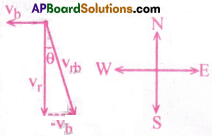
The velocity of rain is vp the velocity of bicycle is vb. Both these velocities are with respect to the ground. Since the woman is riding a bicycle, the velocity of rain as experienced by her is the velocity of rain relative to the velocity of the bicycle. That is
vrb = vr – vb
This relative velocity vector makes an angle θ with the vertical.
It is given by tan θ = \(\frac{v_b}{v_r}=\frac{12}{35}\) = 0.343 ⇒ θ = Tan-1 (0.343) = 19°
Therefore, the woman should hold her umbrella at an angle of about 19° with the vertical towards the west.
Question 3.
The position of a particle is given by r = 3.0t\(\overline{\mathrm{i}}\) + 2.0t²\(\overline{\mathrm{j}}\) +5.0\(\overline{\mathrm{k}}\) where t is in seconds and the coefficients have the proper units for r to be in meters, (a) Find v(t) and a(t) of the particle, (b) Find the magnitude and direction of v(t) at t = 1.0s.
Solution:

Question 4.
Prove the statement “for elevations which exceed or fall short of 45° by equal amounts, the ranges are equal”. [IMP.Q]
Solution:
For a projectile launched with velocity v0 at an angle 90, the range is R = \(\frac{\mathrm{v}_0^2 \sin \left(2 \theta_0\right)}{\mathrm{g}}\)
Now, for angles (45°+ α) and (45°- α) 2θ0 is (90°+ 2α) and (90°- 2α) respectively.
Now, sin(90°+2α) = cos2α and sin(90°-2α) = cos2α
Therefore, ranges are equal for elevations which exceed or fall short of 45° by equal amounts α.
Question 5.
A cricket ball is thrown at a speed of 28 ms-1 in a direction 30° above the horizontal. Calculate (a) the maximum height, (b) the time taken by the ball to return to the same level, and (c) the distance from the thrower to the point where the ball returns to the. same level. [IMP.Q]
Solution:

Exercise Problems
Question 1.
Ship A is 10km due west of ship B. Ship A is heading directly north at a speed of 30 km/h, while jihip B is heading in a direction 60“ west of north at a speed of 20km/h.
(i) Determine the magnitude of the velocity of ship B relative to ship A.
(ii) What will be their distance of closest approach?
Solution:
Assume that ships A and B lie along the X-axis as shown in the diagram.
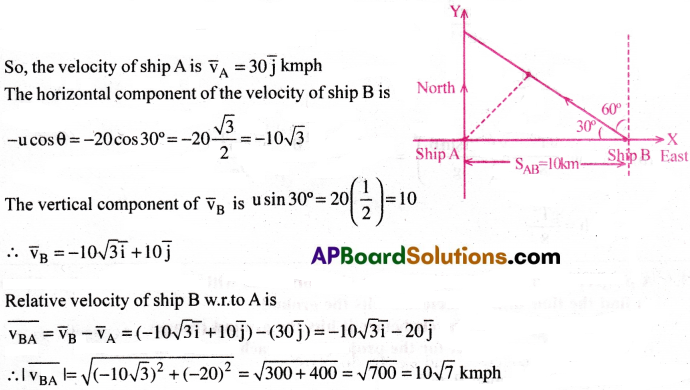
From the concept of relative velocity, ship A may be assumed to be at rest and ship B is moving with a velocity

The closest distance is the perpendicular distance of the relative velocity vector from the fixed position of ship A.
![]()
Question 2.
If θ is angle of projection, R the range, h the maximum height, T the time of flight then . 4h u gT2
show that (a) tan θ = \(\frac{4h}{R}\) (b) h = \(\frac{8T^2}{8}\).
Solution:
If θ is angle of projection and u is the velocity of projection, then we know that
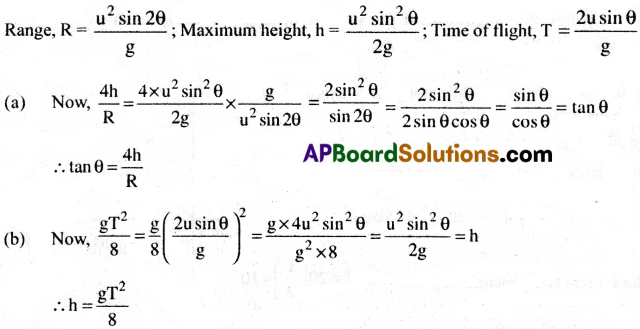
Question 3.
A projectile is fired at angle of 60° to the horizontal with an initial velocity of 800ms-1.
(i) find the time of flight before if hits the ground
(ii) find the distance if travels before it hits the ground (range)
(iii) find the time of flight for the projectile to reach maximum height.
Solution:
Given angle of projection, θ = 60°
Velocity of projection, u = 800 ms-1.

![]()
Question 4.
For a particle projected slantwise from the ground, the magnitude of its position vector with respect to the point of projection, when it is at the highest point of the path is found to he √2 limes the maximum height reached by it. Show that the angle of projection is Tan-1(2).
Solution:
Let P be the maximum height point. Then its coordinates will be (R/2, h). So its position vector
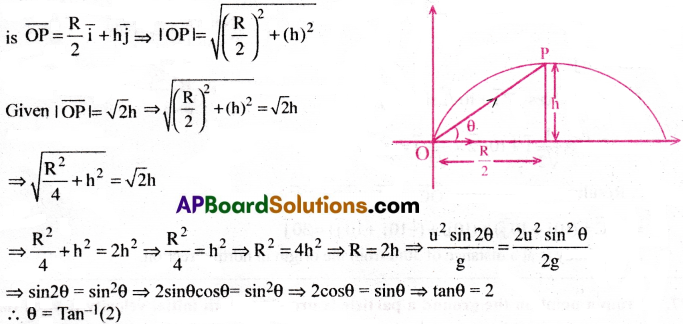
Hence, the angle of projection (θ) = Tan-1(2)
Question 5.
An object is launched from a cliff 20 m above the ground at an angle of 30° above the horizontal with an initial speed of 30 m/s. How far horizontally does the object travel before landing on the ground? (g=10 m/s²)
Solution:
Total horizontal distance travelled, R= R1 +R2.

At the point B, in vertical direction, initial velocity (u) = usinθ
= 30 × sin30° = 30 × \(\frac{1}{2}\) = 15ms-1
Acceleration (a) = g = 10 ms-2; distance travelled (s) = 20m
Time taken (t) = ?
s = ut + \(\frac{1}{2}\) at² ⇒ 20 = 15 × t + \(\frac{1}{2}\) × 10 × t² ⇒ 20 = 15t + 5t² ⇒ 5t² + 15t – 20 = 0
⇒ t² + 3t – 4 = 0 ⇒ t² + 4t – t – 4 = 0 ⇒ t(t+4) – 1(t+4) = 0 ⇒ (t+4)(t-1) = 0 ⇒ t =1 (4 cannot be taken)
Duringthis 1 s, horizontal distance travelled, R2 = ucosθ × t = 30 cos30° × 1 = 30 × \(\frac{\sqrt{3}}{2}\) = 15√3m
∴ Total horizontal distance travelled, R = R1 + R2 =45√3 + 15√3 =60√3 m
Question 6.
O is a point on the ground chosen as origin. A body first suffers a displacement of 10√2m North-East, next 10m North and finally 10√2m in North-West. How far it is from the origin? [TS 19]
Solution:
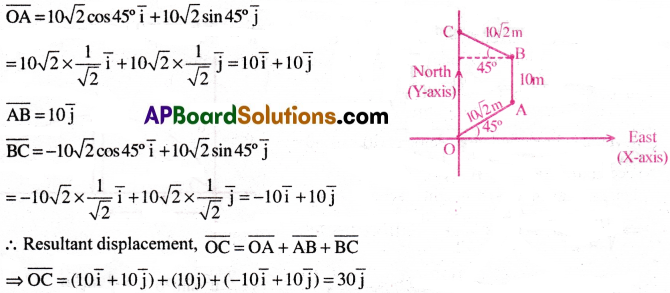
∴ The body is at a distance of 30m from the origin in north direction.
Question 7.
From a point on the ground a particle is projected with initial velocity u, such that its horizontal range is maximum. Find the magnitude of average velocity during its ascent.
Solustion:
For maximum range, the angle of projection is 45°.
The body is projected with a velocity u making an angle 45° with the horizontal. So u can be
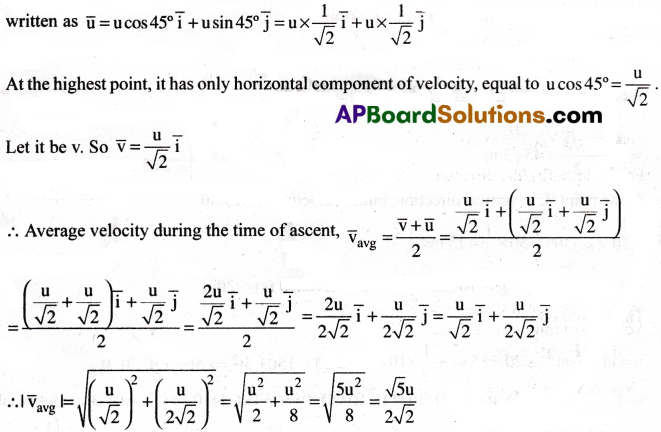
Question 8.
A particle is projected from the ground with some initial velocity making an angle of 45° with the horizontal. It reaches a height of 7:5m above the ground while it travels a horizontal distance of 10m from the point of projection. Find the initial speed of projection. (g = 10m/s²).
Solution:
Let u be the velocity of projection.
Let t be the time taken by the body to travel 10m in the horizontal direction.
But we know that, horizontal distance travelled = uniform velocity × time

Question 9.
Wind is blowing from the south at 5ms-1. To a cyclist is appears to be blowing from the east at 5ms-1. Show that the velocity of the cyclist is 5√2 ms-1 towards north-east.
Solution:
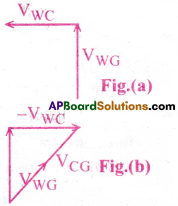
Velocity of wind w.r.to ground VWG = 5ms-1 from South
Velocity of wind w.r.to cyclist, VWG = 5ms-1 from East
Velocity of cyclist w.r.to ground, VCG = ?

![]()
Question 10.
A person walking at 4 m/s finds rain drops falling slantwise into his face with a speed of 4m/s at an angle of 30° with the vertical. Show that the actual speed of the rain drops is 4 m/s.
Solution:
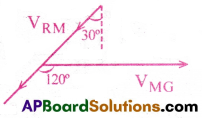
Velocity of rain w.r.to man = VRM = 4 ms-1,
Velocity of man w.r.to ground = VMG = 4ms-1
Velocity of rain w.r.to ground = VRG = ?
(actual velocity of rain)

Multiple Choice Questions
1. If \(\overline{\mathrm{A}}=5\overline{\mathrm{i}}+7\overline{\mathrm{j}}-3\overline{\mathrm{k}}\) and \(\overline{\mathrm{B}}=2\overline{\mathrm{i}}+2\overline{\mathrm{j}}-c\overline{\mathrm{k}}\)B-2i + 2j-ck are mutually perpendicular, then the value of ‘c’ is
1) 2
2) √14
3) √10
4) √5
Answer:
2) √14
2. \(\overline{\mathrm{A}}=2\hat{i}-2\hat{j}+\hat{k}\); B = \(3\hat{i}+6\hat{j}+n\hat{k}\). What is the value of ‘n’ if \(\overline{\mathrm{A}}\) and \(\overline{\mathrm{B}}\) are perpendicular?
1) 6
2) -6
3) 18
4) -18
Answer:
1) 6
3. The angle made by the vector \(\overline{\mathrm{A}}=\overline{\mathrm{i}}+\overline{\mathrm{j}}\) with X-axis is
1) 30°
2) 60°
3) 90°
4) 120°
Answer:
2) 60°
4. Force is \(6\overline{\mathrm{i}}+C\overline{\mathrm{j}}-2\overline{\mathrm{k}}\) and displacement \(\overline{\mathrm{i}}+2\overline{\mathrm{j}}+6\overline{\mathrm{k}}\). If the work done is 6\(\overline{\mathrm{j}}\), the value of ‘C’ is
1) 6
2) 4
3) 8
4) 9
Answer:
1) 6
5. The angle between the vectors (\(\overline{\mathrm{i}}+\overline{\mathrm{j}}\)) and (\(\overline{\mathrm{j}}+\overline{\mathrm{k}}\) + k) is
1) 30°
2) 45°
3) 60°
4) 90°
Answer:
3) 60°
![]()
6. A cricket ball is hit at 45″ to the horizontal with a kinetic energy K. The kinetic energy at the highest point is
1) K
2) K/2
3) Ksin45°
4) 0
Answer:
2) K/2
7. The equations of motion of a projectile are given by x = 36t meter and 2y = 96t – 9.8t² meter. The angle of projection is

Answer:
1
8. The speed of a projectile at its maximum height is √3/2 times its initial speed. If the range of the projectile is p times the maximum height attained by it, then p =
1) 4/3
2) 2√3
3) 4√3
4) 3/4
Answer:
3) 4√3
9. A person throws a bottle into a dustbin at the same height as he is 2m away at an angle of 45°. The velocity of thrown bottle is [EAM Q]
1) g
2) √g
3) 2g
4) √2g
Answer:
4) √2g
10. Identify the vector quantity among the following.
1) Distance
2) Angular momentum
3) Heat
4) Energy
Answer:
2) Angular momentum
11. If a unit vector is represented by \(0.5\hat{i}-0.8\hat{j}+C\hat{k}\) then the value of c is

Answer:
2) √0.11
12. The vectors \(\overrightarrow{A}\) and \(\overrightarrow{B}\) are such that |\(\overrightarrow{A}+\overrightarrow{B}\)| = |\(\overrightarrow{A}-\overrightarrow{B}\)|. The angle between the two vectors is
1) 45°
2) 90°
3) 60°
4) 75°
Answer:
2) 90°
![]()
13. If |\(\overrightarrow{A}+\overrightarrow{B}\)| = \(|\overrightarrow{A}|+|\overrightarrow{B}|\)| then angle between A and B will be
1) 90°
2) 120°
3) 0°
4) 60°
Answer:
3) 0°
14. If the magnitude of sum of two vectors is equal to the magnitude of difference of the two vectors, the angle between these vectors is
1) 45°
2) 180°
3) 0°
4) 90°
Answer:
4) 90°
15. The magnitude of vectors \(\overrightarrow{A},\overrightarrow{B}and\overrightarrow{C}\) are 3, 4 and 5 units respectively. If \(\overrightarrow{A}+\overrightarrow{B}=\overrightarrow{C}\), the angle between \(\overrightarrow{A}and\overrightarrow{B}\) is
1) π/2
2) cos-1(0.6)
3) tan-1(7/5)
4) π/4
Answer:
1) π/2
16. A particle has initial velocity (\(2\hat{i}+3\hat{j}\)) and acceleration (\(0.3\hat{i}+0.2\hat{j}\)). The magnitude of velocity after 10 seconds will be
1) 9√2 units
2) 5√2 units
3) 5 units
4) 9 units
Answer:
2) 5√2 units
17. A particle has initial velocity (\(3\hat{i}+4\hat{j}\)) and has acceleration (\(0.4\hat{i}+0.3\hat{j}\)). Its speed after 10 s is
1) 7 units
2) 7√2 units
3) 8.5 units
4) 10 units
Answer:
2) 7√2 units
18. The horizontal range and the maximum height of a projectile are equal. The angle of projection of the projectile is
1) θ = tan-1 (1/4)
2) θ = tan-1(4)
3) θ = tan-1(2)
4) θ = 45°
Answer:
2) θ = tan-1(4)
![]()
19. For angles of projection of a projectile at angle (45°-0) and (45°+ 0), the horizontal range described by the projectile are in the ratio of
1) 2 : 1
2) 1 : 1
3) 2 : 3
4) 1 : 2.
Answer:
2) 1 : 1
20. A missile is fired for maximum range with an initial velocity of 20 m/s. If g = 10 m/s², the range of the missile is
1) 40 m
2) 50 m
3) 60 m
4) 20 m
Answer:
1) 40 m
21. Two projectiles of same mass and with same velocity are thrown at an angle 60° and 30° with the horizontal, then which will remain same
1) time of flight
2) range of projectile
3) maximum height acquired
4) all of them.
Answer:
2) range of projectile
22. The speed of a projectile at its maximum height is half of its initial speed. The angle of projection is
1) 60°
2) 15°
3) 30°
4) 45°
Answer:
1) 60°
23. The maximum range of a gun of horizontal terrain is 16 km. If g = 10 m s-2, then muzzle velocity of a shell must be
1) 160 ms-1
2) 200√2ms-1
3) 400 ms-1
4) 800 ms-1
Answer:
3) 400 ms-1
24. The velocity of a projectile at the initial point A is (\(2\hat{i}+3\hat{j}\))m/s. Its velocity (in m/s) at point B is
1) \(2\hat{i}-3\hat{j}\)
2) \(2\hat{i}+3\hat{j}\)
3) \(-2\hat{i}-3\hat{j}\)
4) \(-2\hat{i}+3\hat{j}\)
Answer:
1) \(2\hat{i}-3\hat{j}\)
25. A boat is sent across a river with a velocity of 8 kmh-1. If the resultant velocity of boat is 10 kmh-1, then velocity of river is
1) 12.8 kmh-1
2) 6 km h-1
3) 8 kmh-1
4) 10 km h-1
Answer:
2) 6 km h-1
![]()
26. The width of river is 1 km. The velocity of boat is 5 km/hr. The boat covered the width of river in shortest time 15 min. Then the velocity of river stream is
1) 3 km/hr
2) 4 km/hr
3) √29 km/hr
4) √41 km/hr
Answer:
1) 3 km/hr
27. A person aiming to reach exactly opposite point on the hank of a stream is swimming with a speed of 0.5 m/s at an angle of 120° with the direction of flow of water. The speed of water in the stream, is
1) 0.25 m/s
2) 0.5 m/s
3) 1.0 m/s
4) 0.433 m/s
Answer:
1) 0.25 m/s
28. The speed of a swimmer in still water is 20 m/s. The speed of river water is 10 m/s and is flowing due east. If he is standing on the south bank and wishes to cross the river along the shortest path, the angle at which he should make his strokes w.r.t. north is, given by
1) 45° west
2) 30° west
3) 0°
4) 60° west
Answer:
2) 30° west
29. The angular speed of a flywheel making 120 revolutions/minute is
1) 4π rad/s
2) 4π² rad/s
3) π rad/s
4) 4π rad/s
Answer:
1) 4π rad/s
30. Two particles A and B are moving in uniform circular motion in concentric circles of radii rA and rB with speed vA and vB respectively. Their lime period of rotation is the same. ’The ratio of angular speed of A to that of B will be
1) 1 : 1
2) rA : rB
3) vA : vB
4) rB : rA
Answer:
1) 1 : 1
31. A particle moves in x-y plane according to rule x = asinωt and y = acosωt. The particle follows
1) an elliptical path
2) a circular path
3) a parabolic path
4) a straight line path inclined equally to x and y-axes
Answer:
2) a circular path
32. A body is moving with velocity 30 m/s towards east. After 10 seconds its velocity becomes 40 m/s towards north. The average acceleration of the body is
1) 1 m/s²
2 ) 7 m/s²
3) √7 m/s²
4) 5 m/s²
Answer:
4) 5 m/s²
33. The x and y coordinates of the particle at any time are x = 5t – 2t² and y = 10t respectively, where x and y are in metres and t in seconds. The acceleration of the particle at t = 2 s is
1) 5 m s-2
2) -4m s-2
3) -8 m s-2
4) 0
Answer:
2) -4m s-2
![]()
34. A car starts from rest and accelerates at 5 m/s². At t = 4 s, a ball is dropped out of a window by a person sitting in the car. What is the velocity and acceleration of the ball at t = 6 s? (Take g = 10 m/s²)
1) 20√2 m/s, 10 m/s²
2) 20 m/s, 5 m/s²
3) 20 m/s, 0
4) 20√2 m / s, 0
Answer:
1) 20√2 m/s, 10 m/s²